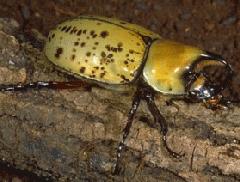Source(s): Jim Howell, Ph.D., Entomologist, The University of Georgia
What do the words elephant, rhinoceros, ox and Hercules have in common? Of course, they are all terms for something bulky and powerful. They’re also common names for a group of large, robust beetles in the family Scarabiidae.
Description
Rhinoceros beetles include the largest beetles in the world, and they’re aptly named, because males have a characteristic horn (females have no horn) that extends forward from its pronotum (the body section behind the head). The gargantuan Hercules beetle – Dynastes hercules, from the rain forests of South America – can reach a length of 8 inches. Its been estimated that some species can lift 850 times their own weight – truly a Herculean feat.
Georgia has several species, but the most common is the eastern Hercules beetle, Dynastes tityus. Specimens range from 1.5 to 2.5 inches long and are usually olive green to tan, with black splotches on the back. The large pronotal horn that extends forward in the males almost meets another horn projecting upward from the head. Adults of this species are the largest beetles in the eastern United States.
Biology and Distribution
The eastern Hercules beetle ranges from southeastern New York to Florida and from Illinois and Indiana to the Gulf of Mexico. Egg laying occurs in the summer, and development may take two to three years. Adults emerge in June and July. Adults are thought to feed mostly on rotten fruits and sap, and the larvae on rotting wood, but relatively little is known of their habits.
This species emits a foul odor to discourage predators but often falls prey to larger insectivores like crows and owls. Adult beetles are attracted to light and are often seen at night around streetlights and the large mercury vapor lamps in shopping centers.
Damage
Rhinoceros beetles do little or no economic damage. They are, instead, a lovely sight to see in our gardens (remember, beauty is in the eye of the beholder). Though these insects may appear foreboding and perhaps even terrifying, they are completely harmless and cannot bite or sting – and, unlike their African namesakes, they cannot gouge you with their horns.
Center Publication Number: 210
- Icky Silverfish are Generally Harmless - September 24, 2013
- Menacing Mice - September 24, 2013
- Opossum Damage and Control - September 24, 2013
